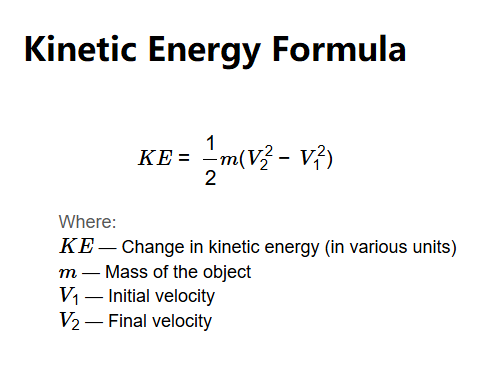 Home
Home
 Back
Back

Definition: This calculator computes the change in kinetic energy (\( KE \)) of an object based on its mass (\( m \)), initial velocity (\( V_1 \)), and final velocity (\( V_2 \)).
Purpose: It is used in physics to analyze the energy associated with an object's motion, applicable in scenarios like vehicle dynamics, sports physics, and mechanical systems.
The calculator uses the relationship:
Where:
Explanation: Enter the mass, initial velocity, and final velocity of the object in the chosen units, and the calculator computes the change in kinetic energy. Results are displayed with 5 decimal places. For default inputs (\( m = 1 \, \text{kg} \), \( V_1 = 5 \, \text{m/s} \), \( V_2 = 10 \, \text{m/s} \)), the calculated change in kinetic energy \( KE \) is approximately 37.50000 Joules.
Details: Kinetic energy quantifies the energy of an object due to its motion. Understanding changes in kinetic energy is crucial for analyzing work, energy transfer, and motion dynamics in physics and engineering applications.
Tips: Enter positive values for mass, initial velocity, and final velocity with up to 4 decimal places (step of 0.0001), then click "Calculate." Results show the change in kinetic energy \( KE \) in Joules, Kilojoules, and Foot-Pounds, always with 5 decimal places.